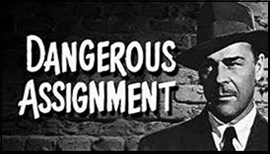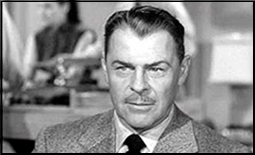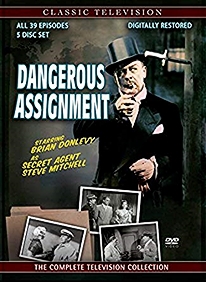Fri 15 Nov 2019
A TV Episode Review: DANGEROUS ASSIGNMENT “The Knitting Needle Story.”
Posted by Steve under Reviews , TV Espionage & Spies[11] Comments

DANGEROUS ASSIGNMENT “The Knitting Needle Story.” Syndicated, though largely to NBC stations. 02 June 1952. (Season 1 Episode 30). Brian Donlevy (Steve Mitchell), Jim Flavin, Jan Arvan, Steve Roberts, Fay Baker, Frances Rafferty. Writers: Writers: Eddie Forman, Adrian Gendot, Robert Ryf. Directo: Bill Karn.
Before its one and only one season on TV, Dangerous Assignment had already been on the radio for several years, in a series also starring Brian Donlevy as a secret agent whose job took him on, well, dangerous assignments all over the world. When the series was passed upon up by all of the then current TV networks, Donlevy decided to pick up the tab himself for one season’s worth of 39 syndicated episodes.
I did not choose to watch “The Knitting Needle Story” for any particular reason. Although the complete series is available on DVD, I just happened to come across this one on YouTube. Based on my memories of watching this when I was young, I can’t say this with certainty, but I think it’s about average for the series, better than some, but perhaps not as good as others.
In this one Steve Mitchell is assigned to be the bodyguard of an Italian news reporter heading by plane back to his native country with a scoop about The Black Hand, important information with international implications. There are naturally those who do not wish him to make it home with the story he has to tell.

Most of the action takes place on the plane, not that there’s a lot of action. There are several twists to the story, though, plus one huge red herring that sounds worth investigation but is dropped almost as quickly. There has to be a lot of skill involved in putting together a story as complete, complicated and still coherent as this one is, and in only 25 minutes.
But as agent Steve Mitchell, Brian Donlevy tries his best to appear suave and debonair, but he comes off as only stolid and solid. James Bond hadn’t come on the scene yet: in book form, he was only a year later. Even if their careers had overlapped a little, Bond would still have had nothing to worry about, not in comparison with he rather dull Steve Mitchell. The latter was of an earlier time, and a different era.
